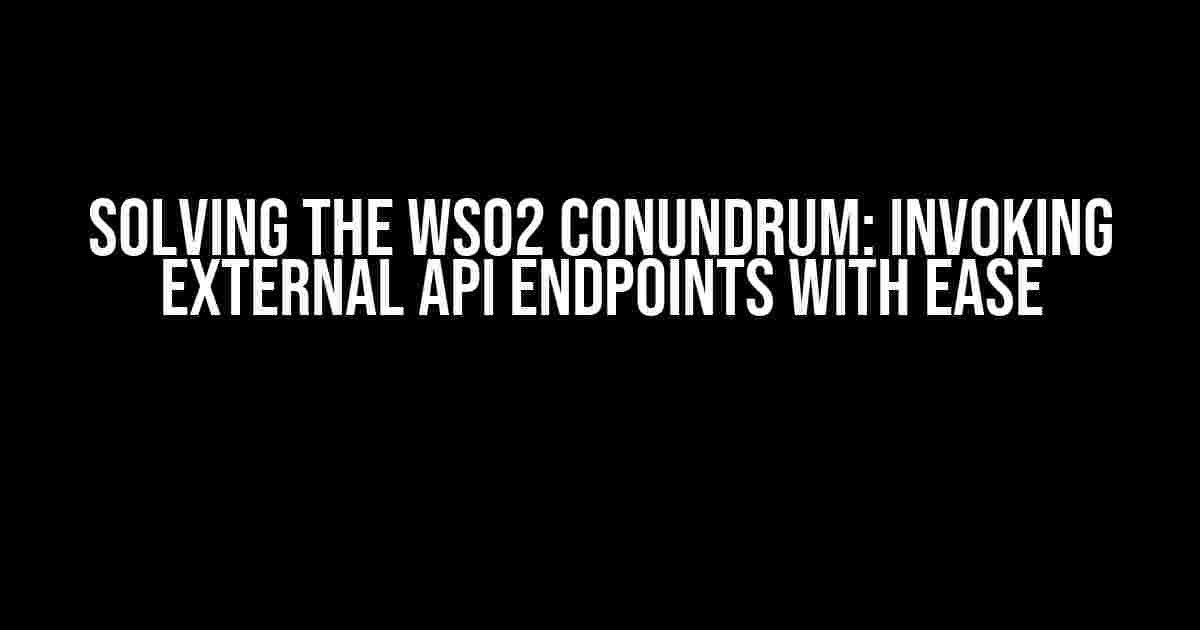Are you tired of banging your head against the wall, trying to figure out why WSO2 won’t play nice with that external API endpoint? You’re not alone! In this article, we’ll dive into the common pitfall of invoking external API endpoints for the second time and provide you with a step-by-step guide to overcome this WSO2 problem.
The Problem: Invoking External API Endpoints for the Second Time
When working with WSO2, you might encounter an issue where the external API endpoint is successfully invoked the first time, but subsequent attempts fail miserably. This can be frustrating, especially when you’re trying to integrate with a critical service.
Causes of the Problem
Before we dive into the solution, it’s essential to understand the possible causes of this problem:
- HTTP Connection Timeout: WSO2’s default HTTP connection timeout can cause the second request to fail.
- TCP Connection Pooling: WSO2’s TCP connection pooling mechanism can lead to socket exhaustion, causing subsequent requests to fail.
- API Endpoint Configuration: Misconfigured API endpoint settings can prevent WSO2 from invoking the external API correctly.
The Solution: Configuring WSO2 for Seamless External API Invocation
Now that we’ve identified the possible causes, let’s get to the solution!
Step 1: Configure HTTP Connection Timeout
WSO2’s default HTTP connection timeout is set to 30 seconds. To avoid timeout issues, you can increase this value by adding the following configuration to your axis2.xml file:
<transportSender name="http" class="org.apache.synapse.transport.passthru.PassThroughHttpSender">
<parameter name="http.socket.timeout">120000</parameter>
</transportSender>
This configuration sets the HTTP connection timeout to 2 minutes (120000 ms).
Step 2: Enable TCP Connection Pooling
By default, WSO2’s TCP connection pooling is disabled. To enable it, add the following configuration to your axis2.xml file:
<transportSender name="http" class="org.apache.synapse.transport.passthru.PassThroughHttpSender">
<parameter name="http.connection.pool.enabled">true</parameter>
</transportSender>
This configuration enables TCP connection pooling, allowing WSO2 to reuse existing connections to the external API endpoint.
Step 3: Configure API Endpoint Settings
Ensure that your API endpoint settings are correctly configured to allow WSO2 to invoke the external API successfully. Check the following:
- Endpoint URL: Verify that the endpoint URL is correct and reachable.
- Authentication: Ensure that authentication credentials, such as usernames and passwords, are correctly configured.
- HTTP Method: Verify that the correct HTTP method (e.g., GET, POST, PUT, DELETE) is used for the API invocation.
Additional Tips for Success
In addition to the above steps, here are some additional tips to ensure successful invocation of external API endpoints:
- Use a Unique Endpoint Address: Ensure that each API endpoint has a unique address to avoid conflicts.
- Caching and Session Management: Implement caching and session management mechanisms to optimize performance and reduce the load on the external API.
- Error Handling and Logging: Implement robust error handling and logging mechanisms to identify and troubleshoot issues quickly.
Conclusion
Invoking external API endpoints in WSO2 can be a breeze if you follow these simple steps and tips. By configuring HTTP connection timeout, enabling TCP connection pooling, and ensuring correct API endpoint settings, you’ll be well on your way to overcoming the WSO2 problem of invoking external API endpoints for the second time.
| Configuration File | Parameter | Description |
|---|---|---|
| axis2.xml | http.socket.timeout | Sets the HTTP connection timeout in milliseconds. |
| axis2.xml | http.connection.pool.enabled | Enables or disables TCP connection pooling. |
Remember, with great power comes great responsibility. Properly configuring WSO2 for external API invocation will ensure seamless integration and a better user experience.
What’s Next?
Now that you’ve overcome the WSO2 problem of invoking external API endpoints for the second time, it’s time to explore more advanced topics, such as:
- Implementing security measures, like OAuth and SSL/TLS, to secure your API invocations.
- Optimizing performance using caching, content compression, and connection pooling.
- Monitoring and logging API invocations for better visibility and troubleshooting.
The possibilities are endless, and with WSO2, you’re limited only by your imagination!
Here are 5 Questions and Answers about “WSO2 problem invoking external API endpoint for the second time”:
Frequently Asked Question
Get answers to the most commonly asked questions about WSO2 problems when invoking external API endpoints for the second time.
Why does WSO2 invoke an external API endpoint successfully for the first time, but fail for subsequent calls?
This might occur due to idle timeout settings in the API Gateway. When the idle timeout is set too low, the connection to the external API endpoint is closed after a short period of inactivity, causing subsequent calls to fail. Increase the idle timeout value to resolve this issue.
Is it possible that WSO2 is not handling the external API endpoint’s rate limiting correctly?
Yes, it’s possible! WSO2 might not be respecting the rate limiting imposed by the external API endpoint, leading to failures on subsequent calls. Check the API endpoint’s documentation for rate limiting policies and configure WSO2 to adhere to these limits.
Could incorrect caching in WSO2 be the culprit behind the issue?
Yes, it’s possible! WSO2’s caching mechanism might be causing the API Gateway to return a stale response instead of invoking the external API endpoint again. Verify your caching configuration and ensure that it’s set up correctly to avoid caching responses unnecessarily.
Are there any firewall or network issues that could be blocking the requests?
Absolutely! Firewalls or network issues can prevent WSO2 from invoking the external API endpoint successfully. Check your network configuration, firewall rules, and ensure that the necessary ports are open for outbound traffic.
How can I debug the issue and identify the root cause?
Enable debug logging in WSO2 to get more detailed error messages and analyze the logs to identify the root cause of the issue. You can also use tools like Wireshark or Tcpdump to capture network traffic and inspect the requests and responses.

